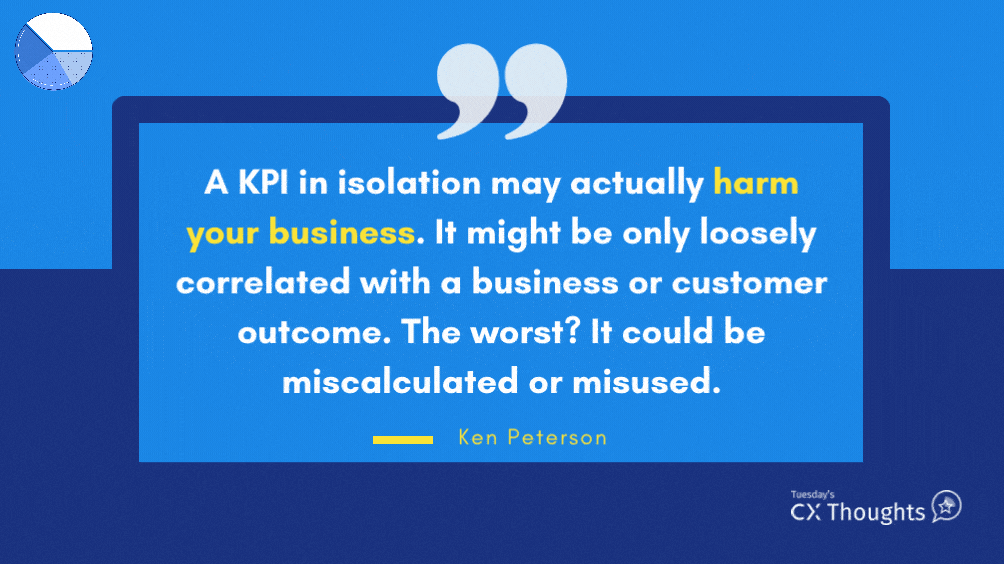 Reading Time: 4 minutes read
Reading Time: 4 minutes readKey Performance Indicator – or commonly referred to as KPI. Seems like a simple and innocuous term until you’ve been assigned one. Building measurable objectives is important.
It is intended to drive the right behaviors that will optimize customer interactions, improve operational processes and net the greatest profitability for the organization among the many touted benefits. If employees don’t have a measuring stick, how do they know if they are doing a good job beyond the occasional compliment from their supervisor, which can be fleeting at times?
The critical role of KPIs in Customer Experience
I come from an operational background – there are so many KPIs that impacted my world when I was in retail: inventory levels, payroll: revenue ratio, time-in-warehouse. Most people would probably yawn at some of these metrics, but they all play a critical role in the customer experience and there are metrics – some similar, some very different – that should be tracked and understood across the entire customer journey if you want to remain in business.
However, without context, a KPI in isolation may actually harm your business. It might be only loosely correlated with a business or customer outcome. It could be misunderstood. The worst? It could be miscalculated or misused.
Even within organizations that actively look to understand the Voice-of-the-Customer as a part of their customer experience strategy, some KPIs can lead a company away from its goals. Here are 4 examples of how that happens:
1. Average Handle Time
I’ve spoken before about my disdain for this measure, especially when it is referenced as a measure for customer experience touchpoints to justify its use. In reality, it is strictly an operational metric. Certainly, we know customers want to be efficiently handled when they contact us, but an average handle time does nothing for the customer in reality. If you want to read more about my thoughts on the metric, I’ve dedicated an article to it here.
2. Ratings vs Loyalty
In the media business, ratings is king of the KPIs. If you ever attend a convention of media programming managers, you’ll likely hear people introduce themselves first with their call signs (Rock 94 ½ KHTQ Spokane) immediately followed up by their market share according to the latest ratings. Actually, that first part is true, but the second part about the ratings is really a facetious comment – still funny to think about.
However, it is probably one of the most talked-about topics among that group. Do the ratings actually reflect listener loyalty? After all, even the rating providers confirm that the ratings are an “estimate”. Similarly, will the box office revenue in the first week tell you if a film will turn into a cult classic with ongoing loyalty? In reality, some metrics have short-term implications and do not reflect long-term loyalty. Join us on our free CX webinar on April 27th, when we speak to radio icons Scott Steele and Brady Hull about how to win the rating game in the Media Industry.
3. Closed-Loop Analytics
This might annoy some in the customer experience software platform industry, but closed-loop analytics are not a great indicator of how a business is doing. In fact, if you have too many customers in the customer feedback loop, no matter how well you manage them after they complain, you’re probably not doing well as a business. If a business only manages the tactical side of closed-loop feedback, they are missing the opportunity to improve strategically. It is why we introduced the Outer Loop as part of our QuestionPro CX platform. Resolving these issues is important for each customer, but fixing systemic problems is at the heart of measuring customer experience. Even a lack of complaints is not indicative of a loyal customer, but I’ll explain that in my next point.
4. Net Promoter Score
By now, you must be wondering if I am turning our industry upside down. In a way, yes. No more so than the mind behind NPS would say, as he does here. There are two truths that I’ve seen since I entered the Customer Experience space nearly a quarter century ago (make me sound old, doesn’t it?).
First, you can keep a customer experience program in place for a very long time if you just tie it to corporate incentives. Second, connecting the NPS score to incentive will ensure that individuals will look to game their score. It is not difficult to see why that would happen.
On the other side of this, the NPS tool was supposed to be more about relationships versus individual transactions. However, if used correctly – one question and one open-end comment, even with some of the best sentiment analysis software you are left working to quantify the “why” behind the “what”. It is a reason we introduced NPS+, to get at the root cause from the perspective of the customer, not the software. It allows for transaction level measurement, and a consistent view of the business’s many touchpoints under a widely known open-source approach.
Measurements are great, especially in Customer Experience
Like everything in life, the usage and application of KPIs must be done with the correct context to make them successful reflections of the business, the loyalty of the customers, and the equally important loyalty of the employees.
While I outline just four examples, I’m sure I could find a KPI in any business that isn’t being used correctly – I have 100% success in that. Or is that a metric that doesn’t reflect reality?
Register for our free CX webinar Ratings vs Engagement: Building Real Loyalty. Join us live on April 27th at 11:00 AM CT as we speak with radio hosts and station managers Scott Steele and Brady Hull about numbers, loyalty, and engagement – and how these lessons can help you build a more efficient customer experience strategy.




















